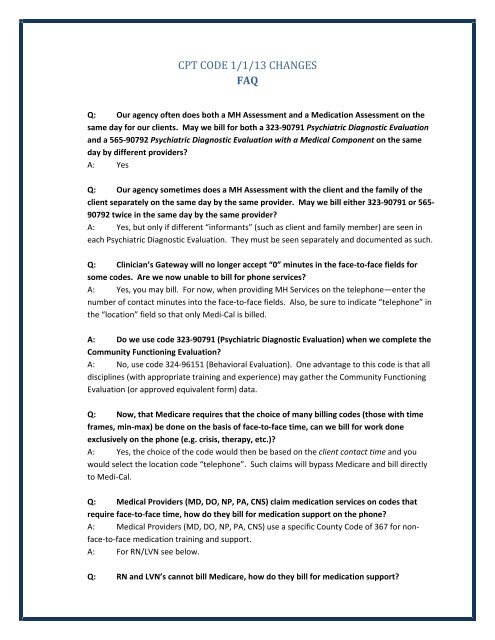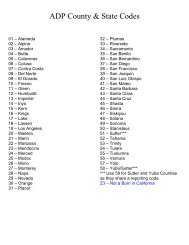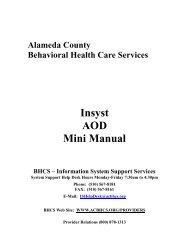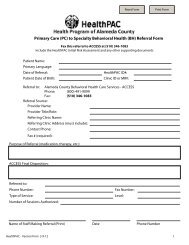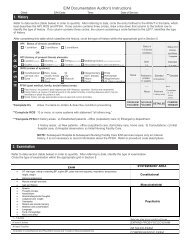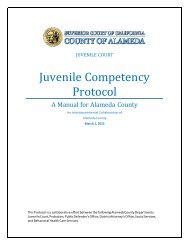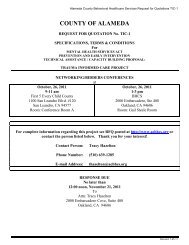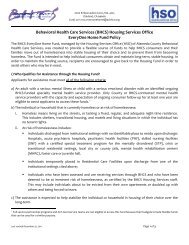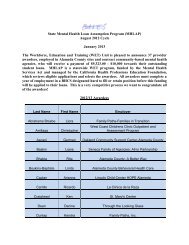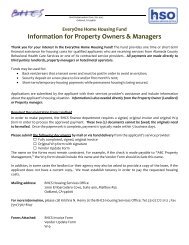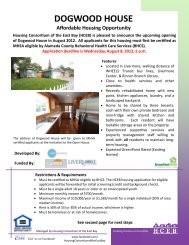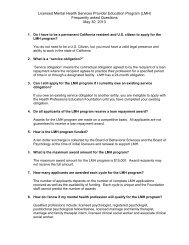CPT CODE 1/1/13 CHANGES FAQ
CPT CODE 1/1/13 CHANGES FAQ
CPT CODE 1/1/13 CHANGES FAQ
You also want an ePaper? Increase the reach of your titles
YUMPU automatically turns print PDFs into web optimized ePapers that Google loves.
<strong>CPT</strong> <strong>CODE</strong> 1/1/<strong>13</strong> <strong>CHANGES</strong><br />
<strong>FAQ</strong><br />
Q: Our agency often does both a MH Assessment and a Medication Assessment on the<br />
same day for our clients. May we bill for both a 323‐90791 Psychiatric Diagnostic Evaluation<br />
and a 565‐90792 Psychiatric Diagnostic Evaluation with a Medical Component on the same<br />
day by different providers?<br />
A: Yes<br />
Q: Our agency sometimes does a MH Assessment with the client and the family of the<br />
client separately on the same day by the same provider. May we bill either 323‐90791 or 565‐<br />
90792 twice in the same day by the same provider?<br />
A: Yes, but only if different “informants” (such as client and family member) are seen in<br />
each Psychiatric Diagnostic Evaluation. They must be seen separately and documented as such.<br />
Q: Clinician’s Gateway will no longer accept “0” minutes in the face‐to‐face fields for<br />
some codes. Are we now unable to bill for phone services?<br />
A: Yes, you may bill. For now, when providing MH Services on the telephone—enter the<br />
number of contact minutes into the face‐to‐face fields. Also, be sure to indicate “telephone” in<br />
the “location” field so that only Medi‐Cal is billed.<br />
A: Do we use code 323‐90791 (Psychiatric Diagnostic Evaluation) when we complete the<br />
Community Functioning Evaluation?<br />
A: No, use code 324‐96151 (Behavioral Evaluation). One advantage to this code is that all<br />
disciplines (with appropriate training and experience) may gather the Community Functioning<br />
Evaluation (or approved equivalent form) data.<br />
Q: Now, that Medicare requires that the choice of many billing codes (those with time<br />
frames, min‐max) be done on the basis of face‐to‐face time, can we bill for work done<br />
exclusively on the phone (e.g. crisis, therapy, etc.)?<br />
A: Yes, the choice of the code would then be based on the client contact time and you<br />
would select the location code “telephone”. Such claims will bypass Medicare and bill directly<br />
to Medi‐Cal.<br />
Q: Medical Providers (MD, DO, NP, PA, CNS) claim medication services on codes that<br />
require face‐to‐face time, how do they bill for medication support on the phone?<br />
A: Medical Providers (MD, DO, NP, PA, CNS) use a specific County Code of 367 for nonface‐to‐face<br />
medication training and support.<br />
A: For RN/LVN see below.<br />
Q: RN and LVN’s cannot bill Medicare, how do they bill for medication support?
A: RN/LVN’s use a County Code 369 for medication support. It may be face‐to‐face (f‐f) or<br />
non‐ f‐f.<br />
Q: Some <strong>CPT</strong> codes now require a minimum amount of client f‐f time, are we unable to<br />
bill for those services if our f‐f time is below the minimum required?<br />
A: You may not use a <strong>CPT</strong> code in which the f‐f time does not meet the minimum required<br />
by the <strong>CPT</strong> manual (i.e. a minimum of 16” for Individual Psychotherapy). However, if there is<br />
another appropriate code (that the service meets) you may claim and chart to that service.<br />
Q: The Crisis Intervention code has been eliminated and replaced with Crisis Therapy<br />
(377‐90839, 378+90840). We have MHRS and Adjunct staff who used to provide Crisis<br />
Intervention services but who are not allowed to do Psychotherapy, may they bill the new<br />
“therapy” code?<br />
A: Yes, the definition of Crisis Intervention Services has not changed—only the Code Label.<br />
With the appropriate training and experience your staff may provide Crisis Intervention<br />
Services—now identified as Crisis Therapy.<br />
Q: In Children’s Services we used to use Code 319 for “Collateral Family Therapy”. We<br />
now see code 4<strong>13</strong>‐90846 (“Family Psychotherapy without Patient Present”) and code 449‐<br />
90847 (“Family Psychotherapy with Patient Present”) on the Master Code List. Which should<br />
we use?<br />
A: Codes 4<strong>13</strong>‐90846 and 449‐90847 have now been added to the Children’s Programs’<br />
RU’s. These are the codes to now use as they are more specific and map to an approved <strong>CPT</strong><br />
code for billing purposes.<br />
Q: The Interactive Complexity add‐on code 491+90785 is used for 456‐90853 Group<br />
Psychotherapy. Can it also be used for 455‐90849 Multi‐Family Group Psychotherapy and/or<br />
391 Group Rehabilitation services?<br />
A: No, the only group related code that the add‐on code 491+90785 Interactive Complexity<br />
may be used with is code 406‐90853 Group Psychotherapy.<br />
Q: The Interactive Complexity add‐on code 491+90785 is used for Individual<br />
Psychotherapy. Can it also be used for 4<strong>13</strong>‐90846 and/or 449‐90847 Family Psychotherapy<br />
codes?<br />
A: No, Interactive Complexity add‐on code may not be used for Family Psychotherapy;<br />
however it may be used with Psychiatric Diagnostic Evaluation (323‐90791, 565‐90792), Group<br />
Psychotherapy (456‐90853), Individual Psychotherapy (441‐90832, 442‐90834, 443‐90837), and<br />
the Individual Psychotherapy add‐on codes (465+90833, 467+90836, 468+90838).<br />
Q: May Interactive Complexity 491+90785 be used with all E/M codes?
A: No, 491+90785 Interactive Complexity add‐on code may only be used in conjunction<br />
with a Primary E/M code which also has a Psychotherapy add‐on code (465+90833, 467+90836,<br />
468+90838) associated with it.<br />
Q: May we bill the Psychiatric Diagnostic Evaluation codes 323‐90791, or 565‐90792<br />
without the client present?<br />
A: Yes, you may review medical records, interview others involved in the client’s care and<br />
still utilize these codes. If you interview the client on the phone—note that as the location code<br />
and you may bill these codes.<br />
Q: How do I enter Interactivity Complexity 491+90785 for billing purposes?<br />
A: In Clinician’s Gateway select “present” in the Interactive Complexity Field.<br />
A: For InSyst, select the 491+90785 code and enter one (1) minute for the duration of<br />
service as a placeholder.<br />
Q: Clinician’s Gateway does not allow me to select multiple 30” Crisis Therapy 378+90840<br />
add‐on codes. May we then only bill for the first 1 1/2 hours of crisis?<br />
A: You may bill for the length of service provided, and Clinician’s Gateway will bill the<br />
appropriate number of 30” Crisis Therapy Add‐on’s to the Insurer. However, when entering<br />
data into the database you total all of the f‐f time beyond the first 60 minutes and enter those<br />
minutes in the “second f‐f minutes” field for the add‐on code.<br />
Q: May we use the Psychiatric Diagnostic Evaluation codes 323‐90791, or 565‐90792, for<br />
re‐assessment purposes?<br />
A: Yes, these codes may be used for both Initial and re‐assessments.<br />
Q: If we provide an E/M service in the field, at school or at a home may we use the E/M<br />
codes 99211‐99215 which indicate “Office or other outpatient visit”?<br />
A: Yes, also select the appropriate “Location Code” when utilizing these E/M codes (e.g.<br />
telephone, field, school, home, etc.).<br />
Q: Clinician’s Gateway used to support Co‐Staffing of a service. It no longer does for<br />
some procedures, may we bill for both of the staff’s time?<br />
A: Yes, if each provider writes a separate note and indicates what unique contribution each<br />
had, or why a second person was needed (e.g. safety). If “duplicate entry” is displayed, select<br />
the reason.<br />
Q: The <strong>CPT</strong> manual indicates Interactive Complexity 491+90785, includes: “Use of play<br />
equipment, interpreter or translator to overcome barriers to diagnostic or therapeutic<br />
interaction”. May we claim Interactive Complexity when we have an Interpreter present to<br />
overcome the language barriers to therapeutic interventions?
A: No, currently CMS has indicated that the Interactive Complexity code “…should not be<br />
used to bill solely for translation or interpretation services as that may be a violation of federal<br />
statue”.<br />
Q: The <strong>CPT</strong> manual indicates Interactive Complexity 491+90785, includes: “Use of play<br />
equipment, interpreter or translator to overcome barriers to diagnostic or therapeutic<br />
interaction”. May we claim Interactive Complexity when we utilize play therapy equipment<br />
for the majority of the session (sand tray, etc.)?<br />
A: Yes, the use of play equipment throughout the session allows you to claim for<br />
Interactive Complexity.<br />
Q: May we choose the time bracketed (min‐max) <strong>CPT</strong> Codes based on total time so that<br />
we may be reimbursed for transportation and documentation time as well as f‐f time?<br />
A: No, <strong>CPT</strong> Codes with time‐frames (min‐max) must be chosen only on the basis of f‐f time<br />
(or contact time if done on the phone). However, you may claim for your time for<br />
transportation and documentation time as below. (Also, see examples, in the Power Point <strong>CPT</strong><br />
Code Jan 20<strong>13</strong> Changes Training.)<br />
A: For Insyst:<br />
<br />
Choose the appropriate code based on the f‐f time and then enter the Total<br />
Number of minutes (inclusive of documentation and travel time) even if the<br />
time exceeds that listed for the code. Do not choose a code which allows for<br />
more time. InSyst will claim to Medicare and Medi‐Cal appropriately behind the<br />
scenes.<br />
If you have needed to choose Crisis Therapy or Psychotherapy add‐on codes—<br />
add the documentation and travel time to the minutes for the last add‐on code<br />
(but do not add an additional add‐on code for those minutes).<br />
A: For Clinician’s Gateway<br />
<br />
<br />
<br />
Choose the appropriate code based on the f‐f time and enter that time in the<br />
“Primary F‐f Time field”. In the “Primary Clinician Time” field, add the f‐f time<br />
with the documentation and travel time and enter the Total Time.<br />
If add‐on codes for Crisis Therapy or Psychotherapy are needed‐‐do not add the<br />
documentation time and travel time to the” Primary Clinician Time” field (just<br />
enter Primary F‐F time). After entering the remaining f‐f time in the “2 nd FF<br />
Time field”‐‐ add the documentation and travel time to the add‐on code’s f‐f<br />
time in the” Secondary Total Time Field”. (Be sure to also indicate the remaining<br />
f‐f time in the 2 nd FF Time field).<br />
See examples, in the Power Point <strong>CPT</strong> Code Jan 20<strong>13</strong> Changes Training.<br />
Q: May we utilize the 690 Mobile Crisis Response Code?<br />
A: No, this code is specific to the “Crisis Response Program’s” RU only. As appropriate use<br />
the Crisis Therapy Codes: 377‐90839 & 378+90840.
Q: May we utilize the “New Patient” E/M codes 545‐9, 992(01‐05)?<br />
A: CBO’s may use these codes if they have not provided Psychiatric Services to the client in<br />
the past three years. Alternatively, they may use Psychiatric Diagnostic Evaluation 565‐90792<br />
(there is no 3 year limit). County Clinics must use the code Psychiatric Diagnostic Evaluation<br />
565‐90792. Any person qualified to use E/M can also use 99212‐15 E/M codes.<br />
Q: In a paper record (not Clinician’s Gateway note) how do we enter the minutes for<br />
crisis when there are multiple add‐on codes, do we break them down per code?<br />
A: You do need to indicate every add‐on code, but then total the minutes (with f‐f time<br />
broken out). For example: 128 minutes f‐f time, 30 minutes documentation and 60 minutes<br />
travel time. Indicate as such:<br />
‐‐‐‐‐‐‐‐‐‐‐‐‐‐‐‐‐‐‐‐‐‐‐‐‐‐‐‐‐‐‐‐‐‐‐‐‐‐‐‐‐‐‐‐‐‐‐‐‐<br />
In Chart:<br />
377‐90839,,378+90840, 378+90840<br />
F‐F 128”, Doc 30”, Travel 60”, Total 218”<br />
‐‐‐‐‐‐‐‐‐‐‐‐‐‐‐‐‐‐‐‐‐‐‐‐‐‐‐‐‐‐‐‐‐‐‐‐‐‐‐‐‐‐‐‐‐‐‐‐‐‐‐‐‐‐<br />
In InSyst:<br />
377‐90839 60"<br />
378+90840 30"<br />
378+90840 128"<br />
__________________________________<br />
Q: May we utilize E/M codes that are not in our program’s RU such as SNF E/M codes?<br />
A: No, programs may only provide those services authorized in their contract. Contact<br />
Provider Relations if you believe you are contracted for a procedure code that is not being<br />
accepted in InSyst.<br />
Q: In Clinician’s Gateway I received an error statement “problem with form”, what does<br />
this indicate?<br />
A: Hover your cursor over the red dot for more information. Call the IS help desk if you<br />
need additional assistance at 510‐567(3)‐8160.<br />
Q: Where can I learn more about the 20<strong>13</strong> <strong>CPT</strong> Psychotherapy/Psychiatric Services<br />
changes—especially utilizing the E/M Codes?<br />
A: See below:<br />
The National Council Resource Page:<br />
• http://www.thenationalcouncil.org/cs/cpt_codes<br />
The American Psychiatric Association Resource Page<br />
• http://www.psych.org/practice/managing‐a‐practice/cpt‐changes‐<br />
20<strong>13</strong>/current‐procedural‐terminology‐cpt‐code‐changes‐for‐20<strong>13</strong><br />
The AACAP<br />
http://www.aacap.org/cs/business_of_practice/reimbursement_for_practitione<br />
rs
The American Psychological Association<br />
<br />
http://www.apapracticecentral.org/reimbursement/billing/psychotherapycodes.pdf<br />
http://www.apapracticecentral.org/reimbursement/billing/index.aspx?__utma=<br />
12968039.338271549.<strong>13</strong>42112804.<strong>13</strong>59501649.<strong>13</strong>6<strong>13</strong>80803.10&__utmb=1296<br />
8039.1.10.<strong>13</strong>6<strong>13</strong>80803&__utmc=12968039&__utmx=‐<br />
&__utmz=12968039.<strong>13</strong>6<strong>13</strong>80803.10.6.utmcsr=google|utmccn=(organic)|utmc<br />
md=organic|utmctr=american psychological association cpt code<br />
changes&__utmv=‐&__utmk=224931866<br />
The AMA<br />
• http://www.ama‐assn.org/ama/pub/physician‐resources/solutions‐managingyour‐practice/coding‐billing‐insurance/cpt.page?<br />
• The AMA app: EM Quickref (android or apple)<br />
• AMA Webinar ‐ Psychotherapy/Psychiatric Services: <strong>CPT</strong> ® 20<strong>13</strong> Changes ‐<br />
Psychotherapy/Psychiatric Services. This one‐hour program discusses the<br />
changes made in the Psychotherapy/Psychiatric Services coding section.


